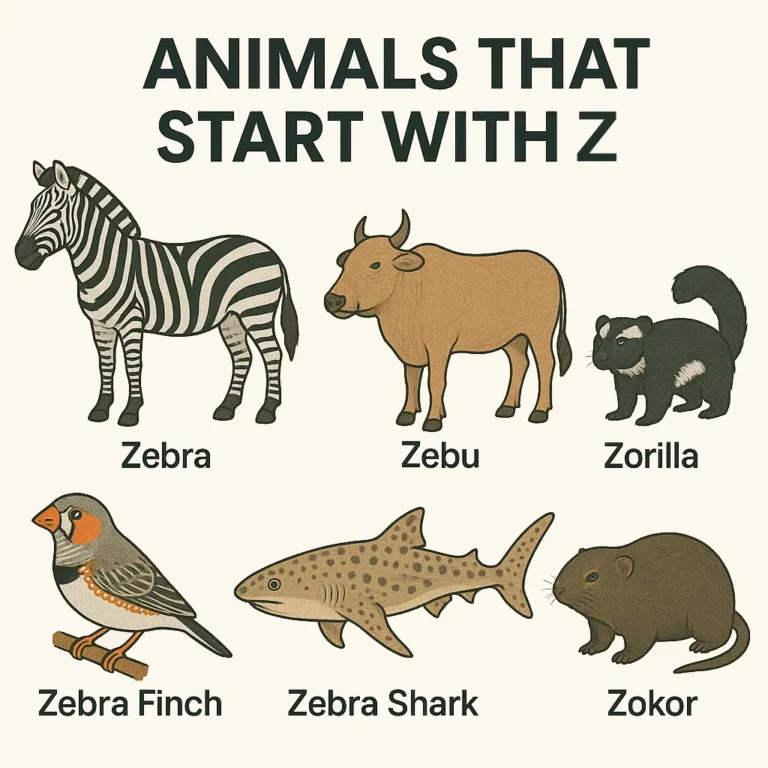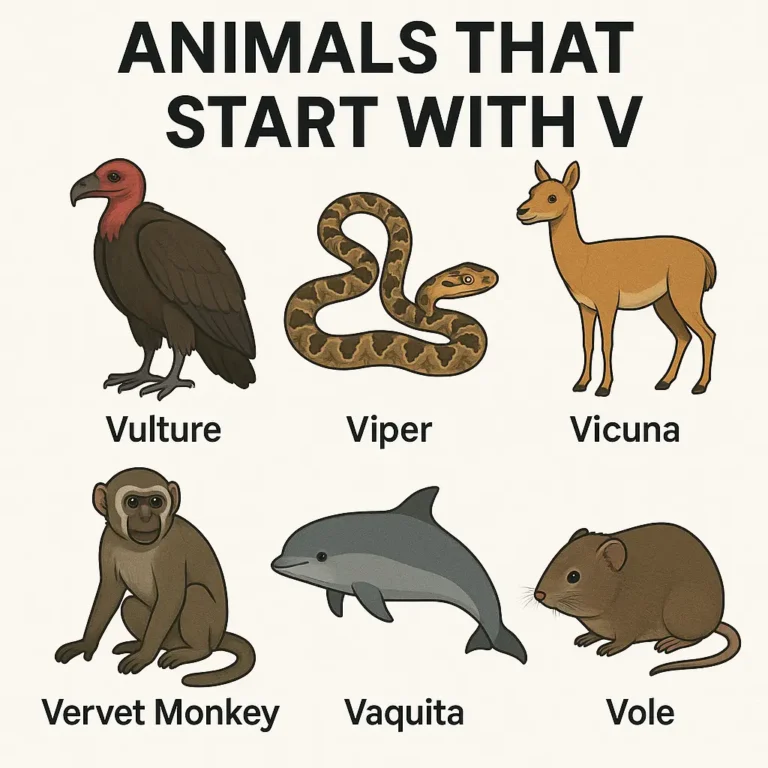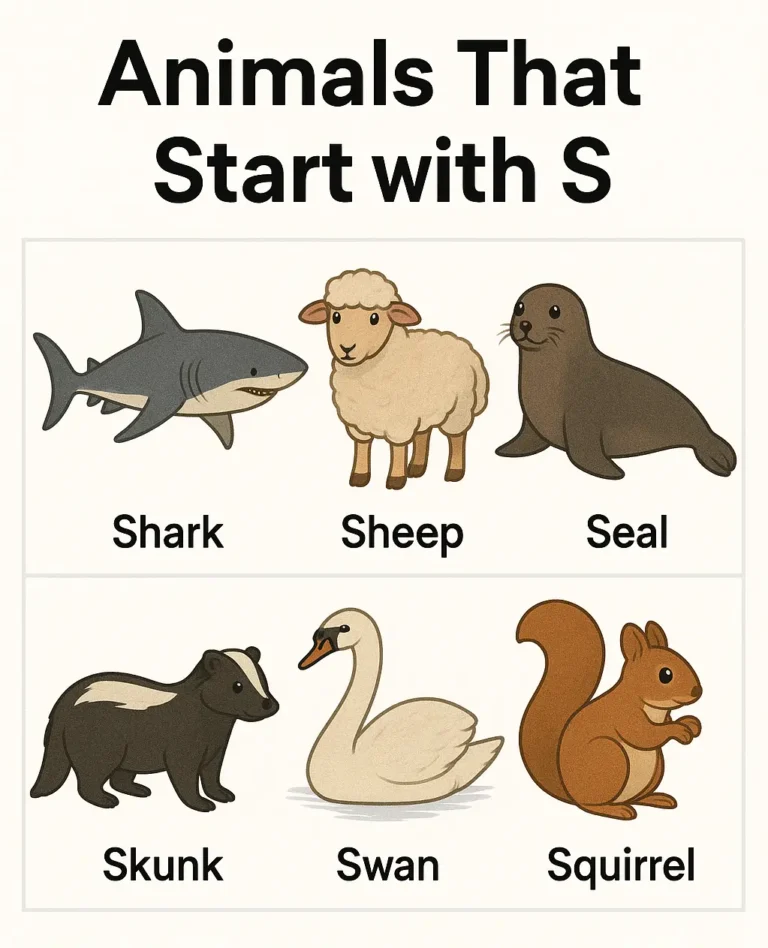Animals That Start With L | List & Examples

Many people search for animal names by letter for different reasons. Students might need them for school projects, parents could be helping kids with homework, or animal lovers simply want to learn more about different species.
This article covers animals that start with the letter L, from common pets to wild creatures around the world.
Here’s the simple list of animals that start with L :
- Labrador Retriever
- Lion
- Llama
- Lemur
- Leopard
- Lynx
- Ladybug
- Lamb
- Lobster
- Lizard
- Llama
- Lark
- Loon
- Lungfish
- Leafy Sea Dragon
- Lacewing
- Leech
- Limpet
- Locust
- Longhorn Beetle
- Loris
- Lungworm
- Lovebird
- Lamprey
- Lancetfish
- Leafcutter Ant
- Leather Turtle
- Lechwe
- Legless Lizard
- Lemon Shark
- Leopard Gecko
- Leopard Seal
- Lesser Panda
- Leveret
- Liger
- Limpkin
- Linnet
- Lionfish
- Littleneck Clam
- Lizardfish
- Llama
- Lobster
- Loggerhead Turtle
- Long-eared Owl
- Longfin Eel
- Loon
- Lorikeet
- Lowland Gorilla
- Lucifer Hummingbird
- Lungfish
- Lynx
- Lyrebird
- Ladybird
- Lake Trout
- Lammergeier
- Lancehead Snake
- Langur
- Lapwing
- Large Mouth Bass
- Latimeria
- Laughing Gull
Check out the animals that start with the letter M
Domestic Animal Names That Start With L
Here’s the simple list of domestic animals that start with L :
- Labrador Retriever
- Labradoodle
- Lakeland Terrier
- Lamb
- Leghorn Chicken
- Lhasa Apso
- Lionhead Rabbit
- Llama
- Longhorn Cattle
- Lovebird
- Lowchen
- Lundehund
- Lurcher
1. Labrador Retriever
The Labrador Retriever is one of the most popular dog breeds in the world. These friendly dogs originally came from Newfoundland, Canada, where fishermen used them to help retrieve fish and nets from the water.
Labradors make excellent family pets because they are gentle, smart, and easy to train. They love to swim and play fetch, which makes them great companions for active families. These dogs come in three main colors: yellow, black, and chocolate brown.
Most Labradors live between 10 to 12 years and weigh between 55 to 80 pounds when fully grown. They need daily exercise and enjoy being around people, which is why they don’t do well when left alone for long periods.
2. Llama
Llamas are domesticated animals that belong to the camel family. People in South America have raised llamas for thousands of years, mainly in countries like Peru, Bolivia, and Ecuador. These animals live high up in the Andes Mountains.
Farmers use llamas for many purposes. Their soft wool makes warm clothing, and they can carry heavy loads across mountain trails. Llamas are also good guard animals that protect sheep and goats from predators like coyotes.
These animals are known for spitting when they feel threatened or annoyed. Llamas can live up to 20 years and typically weigh between 280 to 450 pounds. They eat grass, hay, and other plants.
3. Lovebird
Lovebirds are small, colorful parrots that many people keep as pets. These birds got their name because they often sit close together and show affection to their mates. In the wild, lovebirds come from Africa and Madagascar.
Pet lovebirds are usually very social and need lots of attention from their owners. They can learn to mimic some words and sounds, though they’re not as talkative as larger parrots. These birds live about 10 to 15 years in captivity.
Lovebirds are only about 5 to 7 inches long and weigh less than 2 ounces. They need a varied diet of seeds, fruits, and vegetables to stay healthy. Many lovebirds do better when kept in pairs because they naturally want companionship.
4. Lamb
A lamb is a young sheep that is less than one year old. Farmers raise sheep for their wool, meat, and milk. Lambs are born in the spring and stay close to their mothers for several months.
These animals are domesticated and live on farms around the world. Baby lambs can walk within minutes of being born, and they recognize their mother’s voice among many other sheep. Lambs drink their mother’s milk for the first few weeks of life.
Sheep farming is important in many countries, including Australia, New Zealand, and the United Kingdom. Adult sheep can live 10 to 12 years and provide wool that people use to make clothing and blankets.
5. Leghorn Chicken
Leghorn chickens are a popular breed of domestic chicken known for laying lots of white eggs. These birds originally came from Italy but are now raised on farms worldwide. They are excellent egg producers and can lay about 280 to 320 eggs per year.
Leghorns are usually white in color, though they can also be brown, black, or other colors. They are smaller than some other chicken breeds and are very active birds that like to forage for food. These chickens are good at flying short distances compared to heavier breeds.
Farmers like Leghorn chickens because they start laying eggs at a young age and don’t eat as much food as larger chickens. They typically live 5 to 8 years and adapt well to different climates.
Wild Animal Names That Start With L
Here’s the simple list of wild animals that start with L :
- Lion
- Leopard
- Lynx
- Lemur
- Lizard
- Lobster
- Ladybug
- Lark
- Loon
- Lungfish
- Leafy Sea Dragon
- Lacewing
- Leech
- Limpet
- Locust
- Longhorn Beetle
- Loris
- Lamprey
- Lancetfish
- Leafcutter Ant
- Leather Turtle
- Lechwe
- Legless Lizard
- Lemon Shark
- Leopard Gecko
- Leopard Seal
6. Lion
Lions are large wild cats that live mainly in Africa, with a small population in India. These powerful animals are known as the “king of the jungle,” even though they actually live in grasslands and savannas, not jungles.
Male lions have thick manes around their heads that make them look bigger and more intimidating. Lions live in groups called prides, which usually include several related females, their cubs, and one or two adult males. This makes them different from most other cats, which live alone.
Lions are carnivores that hunt large animals like zebras, wildebeest, and antelope. They can run up to 50 miles per hour for short distances. Adult male lions can weigh up to 420 pounds, while females are usually smaller at around 280 pounds.
7. Leopard
Leopards are spotted wild cats that live in Africa and Asia. These animals are excellent climbers and often drag their prey up into trees to keep it safe from other predators. Leopards are smaller than lions and tigers but are very strong for their size.
Each leopard has a unique pattern of spots called rosettes. These markings help them blend into their surroundings when hunting. Leopards are solitary animals that prefer to live and hunt alone, unlike lions.
These cats are very adaptable and can live in many different habitats, from forests to deserts. Leopards are good swimmers and can leap up to 20 feet horizontally. They typically weigh between 60 to 200 pounds depending on their location and gender.
8. Lemur
Lemurs are primates that live only on the island of Madagascar and nearby islands off the coast of Africa. These animals come in many different sizes and colors, from tiny mouse lemurs to larger ring-tailed lemurs.
The ring-tailed lemur is probably the most famous type of lemur. It has a long black and white striped tail that it uses for balance and communication. Lemurs live in groups and are very social animals that spend time grooming each other.
Many lemur species are endangered because their forest homes are being destroyed. Lemurs eat mainly fruits, leaves, and insects. They have excellent night vision and many species are most active during dawn and dusk.
9. Lynx
Lynx are wild cats with short tails and tufted ears that live in forests across North America, Europe, and Asia. These cats have large, furry paws that work like snowshoes to help them walk on deep snow during winter.
There are four different species of lynx, including the Canadian lynx and the Eurasian lynx. They are skilled hunters that primarily eat rabbits, hares, and other small animals. Lynx have excellent eyesight and can spot a mouse from 250 feet away.
These cats are solitary and mark their territory with scent markings. Lynx typically weigh between 18 to 60 pounds depending on the species. They have thick fur that changes color with the seasons to help them blend into their environment.
10. Ladybug
Ladybugs are small, round beetles that are usually red or orange with black spots. These insects are beneficial to farmers and gardeners because they eat aphids and other pests that damage plants. A single ladybug can eat up to 5,000 aphids in its lifetime.
Ladybugs go through a complete metamorphosis, starting as eggs, then becoming larvae, pupae, and finally adult beetles. In winter, they often gather in large groups under rocks or logs to hibernate until spring.
These insects are found all over the world and come in many colors, including yellow, pink, and black. Ladybugs can live up to two years and are considered good luck in many cultures around the world.
11. Lizard
Lizards are reptiles that come in thousands of different species worldwide. They have scaly skin, four legs, and most have long tails. Lizards are cold-blooded, which means they need to warm up in the sun to become active.
Most lizards eat insects, though some larger species eat plants or other animals. Geckos are a type of lizard that can walk on walls and ceilings using special pads on their feet. Some lizards, like chameleons, can change color to blend in with their surroundings.
Many lizards can regrow their tails if they lose them to escape from predators. Lizards live in almost every habitat on Earth except Antarctica. They range in size from tiny geckos less than an inch long to giant monitor lizards that can grow over 10 feet long.
12. Lobster
Lobsters are large marine crustaceans that live on the ocean floor. These animals have hard shells, long antennae, and powerful claws that they use to catch prey and defend themselves. Lobsters are related to shrimp and crabs.
American lobsters can live for over 100 years and continue growing throughout their lives. They shed their shells as they grow, a process called molting. During this time, they are very vulnerable until their new shell hardens.
Lobsters are scavengers that eat dead fish, plants, and other organic matter on the sea floor. They have excellent senses of smell and taste, which help them find food in the dark ocean depths. Lobsters are important both ecologically and economically in many coastal areas.
13. Loon
Loons are waterbirds known for their haunting calls that echo across lakes and ponds. These birds are excellent swimmers and divers, using their webbed feet to propel themselves underwater while hunting for fish. Loons have solid bones, unlike many other birds, which helps them dive deeper.
Common loons have distinctive black and white plumage with red eyes. They build their nests right at the water’s edge because their legs are positioned far back on their bodies, making walking on land difficult. Baby loons often ride on their parents’ backs for protection.
Loons need large bodies of water to take off when flying because they have small wings relative to their body size. They migrate between northern breeding grounds and southern wintering areas. These birds can live up to 30 years in the wild.
14. Lungfish
Lungfish are unusual fish that can breathe air using primitive lungs in addition to their gills. These ancient fish have existed for millions of years and are found in Africa, Australia, and South America. They represent an important link in the evolution between fish and land animals.
During dry seasons, African lungfish can survive out of water by burying themselves in mud and breathing air. They create a cocoon-like structure and can remain dormant for months until water returns. This ability helps them survive in areas where water sources dry up regularly.
Lungfish eat worms, insects, and small fish. They have both fins and primitive limb-like appendages that help them move through shallow water and muddy areas. These remarkable fish can live for over 100 years.
15. Leafy Sea Dragon
Leafy sea dragons are marine fish related to seahorses that live in the waters around southern Australia. These amazing creatures have leaf-like appendages all over their bodies that make them look exactly like floating seaweed. This camouflage helps them hide from predators and prey.
Unlike seahorses, leafy sea dragons cannot wrap their tails around objects to anchor themselves. They drift with the ocean currents and move very slowly using tiny fins. Males carry the eggs during breeding season, attaching them to their tails until they hatch.
Leafy sea dragons eat tiny shrimp and other small crustaceans by sucking them up with their long snouts. They are the official marine emblem of South Australia and are protected by law. These delicate creatures face threats from pollution and habitat loss.
Conclusion
This article covered many different animals that start with the letter L, from beloved pets like Labrador Retrievers and lovebirds to wild creatures like lions and lemurs. You learned about domestic animals that people keep as companions or raise on farms, as well as wild animals that live in oceans, forests, and grasslands around the world.
Each animal that starts with L has its own unique characteristics and plays an important role in its ecosystem. Whether you’re interested in the loyalty of a Labrador, the majesty of a lion, or the unusual breathing abilities of a lungfish, there’s always something fascinating to discover about these creatures.
If you found this helpful, you might want to explore animals that start with other letters of the alphabet. Each letter offers its own collection of interesting species to learn about.






